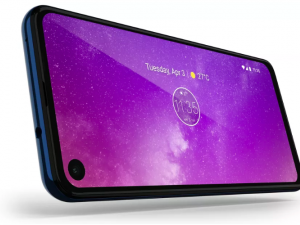OnePlus 7 And 7 Pro: Everything You Need To Know
Damien McFerran 15/05/2019 – 8:59am
What's the difference?
OnePlus has long been a major player in the smartphone arena but with the launch of its latest range, it has entered a new phase in its evolution. This year, OnePlus is releasing not one but two phones at roughly the same time, following the lead of companies like Apple, Samsung and Google by offering consumers a wider degree of choice at the point of purchase. But what's all the fuss about? What makes the new OnePlus 7 range so special, and which model should you go for? Allow us to help out.
OnePlus 7 and OnePlus 7 Pro – What's the Difference?

As the 'Pro' naming suggests, the OnePlus 7 Pro is the more premium of the two models, which will be released at slightly different times. While the standard OnePlus 7 looks very similar to the OnePlus 6T – complete with teardrop notch – the Pro has some sweeping design changes that make it feel like an entirely different device when compared to the standard offering. The Pro also has a faster screen refresh rate, better cameras (including a pop-up selfie cam), a larger battery and faster charging. We'll break down the key differences below.
OnePlus 7 and OnePlus 7 Pro: The Design

Starting with the OnePlus 7, the design is very similar to the OnePlus 6T – which is no bad thing as that was an exceptionally handsome phone. The front of the device is dominated by the 6.4-inch, AMOLED, FHD+ display, complete with teardrop notch and a 60Hz refresh rate. On the back, there are two cameras, and the 3.5mm headphone jack is gone – OnePlus got rid of that on its previous phone.
The OnePlus 7 Pro looks very similar in terms of its basic design, but there are some key differences. For starters, the massive 6.7-inch 'Fluid AMOLED' has a QHD+ resolution and a 90Hz refresh rate, which means animations and movement will look smoother. There's also no notch, as the selfie cam is concealed in a pop-up mechanism which rises up from the top of the device when it's needed. Around the back, you'll notice an extra camera when compared to the bog-standard OnePlus 7; this is an ultra-wide snapper for truly epic shots.
Both phones have in-screen fingerprint scanners. This feature was introduced on the OnePlus 6T. They also have stereo speakers this time around; the 6T only had a single speaker. There's no water resistance rating on either phone, which won't come as a shock to OnePlus fans as the company has never seen much point in chasing such ratings.
OnePlus 7 and OnePlus 7 Pro: The Specs

Despite their cosmetic differences, the underlying specs on both of these phones are pretty similar. They're both powered by Qualcomm's Snapdragon 855 chipset, the company's flagship silicon for 2019. It's the same chip that is found inside the Samsung Galaxy S10 and Black Shark 2. RAM for the standard model is either 6 or 8, while the Pro comes in 6, 8 and 12GB models. Both versions are available in either 128 or 256GB storage options (with the RAM rising in each variant, too).
In terms of battery, the larger Pro model has (unsurprisingly) a bigger battery; it's packing a 4000mAh cell, while the standard model has a 3700mAh battery. The differences don't end there; the Pro has 'Warp Charge', OnePlus' own charging standard that has 30-watt fast charging. It's not a new thing – it was actually introduced on the McLaren edition of the OnePlus 6T – but it's impressive nonetheless. The standard OnePlus 7 doesn't have Warp Charge, and instead has to make do with Fast Charge, which can only manage 18 watts.
The big bummer is that OnePlus still hasn't embraced wireless charging, which is a pretty common feature on flagship phones these days.
OnePlus 7 and OnePlus 7 Pro: The Camera
The star here is clearly the OnePlus 7 Pro, which has three different cameras on the back: a 48-megapixel main sensor, a 16-megapixel ultra-wide camera, and an 8-megapixel telephoto snapper. A new focusing system – which uses phase-detect AF, contrast AF, and laser focusing – should improve shooting in all kinds of conditions.
Both phones benefit from OnePlus' improved Night Scape mode for low-light shooting, and can record 4K video at 60fps.
OnePlus 7 and OnePlus 7 Pro: The Price

Naturally, given the differences between the two phones, there's quite a gulf in price. The standard OnePlus 7 is the cheapest entry point, with the 6GB RAM, 128GB model costing just £499 – a similar price to the OnePlus 6T. If you want more storage, then the 8GB RAM, 256GB version is £549. The OnePlus 7 won't launch in the UK until June and it's worth noting that the OnePlus 7 will not be launching in the US at all. The only colour version available for the OnePlus 7 is 'Mirror Grey'.
The OnePlus 7 Pro is perhaps the phone people will be most interested in, and it naturally has a higher price point than its smaller sibling. It starts at £649 for the base spec and goes all the way up to £799 (which is still cheaper than the iPhone XS).
- 6GB RAM, 128GB (Mirror Grey) – £649
- 8GB RAM, 256GB (Mirror Grey) – £699
- 8GB RAM, 256GB (Almond) – £699
- 8GB RAM, 256GB (Nebula Blue) – £699
- 12GB RAM, 256GB (Nebula Blue) – £799
OnePlus 7 and OnePlus 7 Pro: The Conclusion

It might seem obvious, but the OnePlus 7 Pro is clearly the more interesting of these two phones. The faster screen refresh rate and notchless display are going to be big selling points for most people, as is the inclusion of a third camera on the back. You can also take into account faster charging and a slightly larger battery (although it's worth noting that the Pro model has a bigger screen so there may be little different in terms of stamina).
However, the Pro model is bigger in terms of size and that mechanical pop-up camera will eventually wear out (OnePlus says its good for 300,000 movements, but anything with moving parts could potentially fail). If you're simply looking for a cutting edge phone for the best price, then the standard OnePlus 7 at £500 is amazing value for money – and it's worth noting that you get the same processor (Snapdragon 855) and Android 9.




